Minimizing Porosity in 17-4 PH Stainless Steel Compacts in a Modified Powder Metallurgical Process
Abstract
1. Introduction
2. Materials and Methods
3. Results
3.1. Effect of Milling on the Powder
3.2. Densification during Sintering at Different Temperatures
3.3. Hardness
3.4. Tensile Properties
3.5. Charpy Test
4. Conclusions
Author Contributions
Funding
Data Availability Statement
Conflicts of Interest
References
- Kareem, Q.M.; Mikó, T.; Gergely, G.; Gácsi, Z. Compaction Behaviors of 17-4ph, 316l, and 1.4551 Stainless-Steels Powders by Cold Pressing Method. SSRN 2024, 23, 4827283. [Google Scholar] [CrossRef]
- Seerane, M.N.; Machaka, R. Metal injection moulding of 17-4PH stainless steel: Effects of porosity on the mechanical properties of the sintered products. Mater. Sci. Eng. 2019, 655, 012033. [Google Scholar] [CrossRef]
- Kovacs, S.E.; Miko, T.; Troiani, E.; Markatos, D.; Petho, D.; Gergely, G.; Varga, L.; Gacsi, Z. Additive Manufacturing of 17-4PH Alloy: Tailoring the Printing Orientation for Enhanced Aerospace Application Performance. Aerospace 2023, 10, 619. [Google Scholar] [CrossRef]
- Radhakrishnan, J.; Kumar, P.; Gan, S.S.; Bryl, A.; McKinnell, J.; Ramamurty, U. Microstructure and tensile properties of binder jet printed 17–4 precipitation hardened martensitic stainless steel. Mater. Sci. Eng. A 2022, 860, 144270. [Google Scholar] [CrossRef]
- Suri, P.; Smarslok, B.P.; German, R.M. Impact properties of sintered and wrought 17–4 PH stainless steel. Powder Metall. 2006, 49, 40–47. [Google Scholar] [CrossRef]
- Pasebani, S.; Ghayoor, M.; Badwe, S.; Irrinki, H.; Atre, S.V. Effects of atomizing media and post processing on mechanical properties of 17-4 PH stainless steel manufactured via selective laser melting. Addit. Manuf. 2018, 22, 127–137. [Google Scholar] [CrossRef]
- ASTM A693-16(2022); Standard Specification for Precipitation-Hardening Stainless and Heat-Resisting Steel Plate, Sheet, and Strip. ASTM: West Conshohocken, PA, USA, 2022.
- ASTM A564; Standard Specification for Hot-Rolled and Cold-Finished Age-Hardening Stainless Steel Bars and Shapes. ASTM: West Conshohocken, PA, USA, 2017. [CrossRef]
- Seerane, M.; Ndlangamandla, P.; Machaka, R. The influence of particle size distribution on the properties of metal-injection-moulded 17-4 PH stainless steel. J. South. Afr. Inst. Min. Metall. 2016, 116, 935–940. [Google Scholar] [CrossRef][Green Version]
- Sung, H.J.; Ha, T.K.; Ahn, S.; Chang, Y.W. Powder injection molding of a 17-4 PH stainless steel and the effect of sintering temperature on its microstructure and mechanical properties. J. Mater. Process. Technol. 2002, 130, 321–327. [Google Scholar] [CrossRef]
- Cho, Y.H.; Park, S.Y.; Kim, J.Y.; Lee, K.A. 17-4PH stainless steel with excellent strength -elongation combination developed via material extrusion additive manufacturing. J. Mater. Res. Technol. 2023, 24, 3284–3299. [Google Scholar] [CrossRef]
- Irrinki, H.; Jangam, J.S.D.; Pasebani, S.; Badwe, S.; Stitzel, J.; Kate, K.; Gulsoy, O.; Atre, S.V. Effects of particle characteristics on the microstructure and mechanical properties of 17-4 PH stainless steel fabricated by laser-powder bed fusion. Powder Technol. 2018, 331, 192–203. [Google Scholar] [CrossRef]
- Kazior, J.; Szewczyk-Nykiel, A.; Pieczonka, T.; Hebda, M.; Nykiel, M. Properties of Precipitation Hardening 17-4 PH Stainless Steel Manufactured by Powder Metallurgy Technology. Adv. Mater. Res. 2013, 811, 87–92. [Google Scholar] [CrossRef]
- Samal, P.K.; Nandivada, N.; Iet, H. Properties of 17-4ph stainless steel produced via press and sinter route. Adv. Powder Metall. Part. Mater. 2008, 7, 109–120. [Google Scholar]
- Reinshagen, J.H.; Witsberger, J.C. Properties of Precipitation Hardening Stainless Steel Processed By Conventional Powder Metallurgy Techniques. In Advances in Powder Metallurgy & Particulate Materials; Lall, C., Neupaver, A., Eds.; Metal Powder Industries Federation: Princeton, NJ, USA, 1994; Volume 3, Part 7; pp. 313–339. [Google Scholar]
- Kazior, J. Influence of Sintering Atmosphere, Temperature and the Solution-Annealing Treatment on the Properties of Precipitation-Hardening Sintered 17-4 PH Stainless Steel. Materials 2023, 16, 760. [Google Scholar] [CrossRef] [PubMed]
- Moon, I.H.; Kim, K.H. Relationship between Compacting Pressure, Green Density, and Green Strength of Copper Powder Compacts. Powder Metall. 1984, 27, 80–84. [Google Scholar] [CrossRef]
- Raynova, S.; Collas, Y.; Yang, F.; Bolzoni, L. Advancement in the Pressureless Sintering of CP Titanium Using High-Frequency Induction Heating. Metall. Mater. Trans. A 2019, 50, 4732–4742. [Google Scholar] [CrossRef]
- Sethi, G.; Myers, N.S.; German, R.M. An overview of dynamic compaction in powder metallurgy. Int. Mater. Rev. 2008, 53, 219–234. [Google Scholar] [CrossRef]
- Tremblay, L.; Chagon, F.; Thomas, Y. Enhancing green strength of P/M materials. Adv. Powder Metall. Part. Mater. 2001, 3, 3–129. [Google Scholar]
- German, R.M. Powder Metallurgy Science; MPFI: Princeton, NJ, USA, 1984; ISBN 0-918404-60-6. [Google Scholar]
- Wu, Y.; German, R.M.; Blaine, D.; Marx, B.; Schlaefer, C. Effects of residual carbon content on sintering shrinkage, microstructure and mechanical properties of injection molded 17-4 PH stainless steel. J. Mater. Sci. 2002, 37, 3573–3583. [Google Scholar] [CrossRef]
- Nezhadfar, P.D.; Shrestha, R.; Phan, N.; Shamsaei, N. Fatigue behavior of additively manufactured 17-4 PH stainless steel: Synergistic effects of surface roughness and heat treatment. Int. J. Fatigue 2019, 124, 188–204. [Google Scholar] [CrossRef]
- Hideki, K.; Shinichiro, K.; Hideki, N.; Hiroyuki, J.; Kazumitsu, S. Advances in Powder Metallurgy and Particulate Materials; MPIF: Princeton, NJ, USA, 1997; Volume 3, Part 18; pp. 125–144. [Google Scholar]
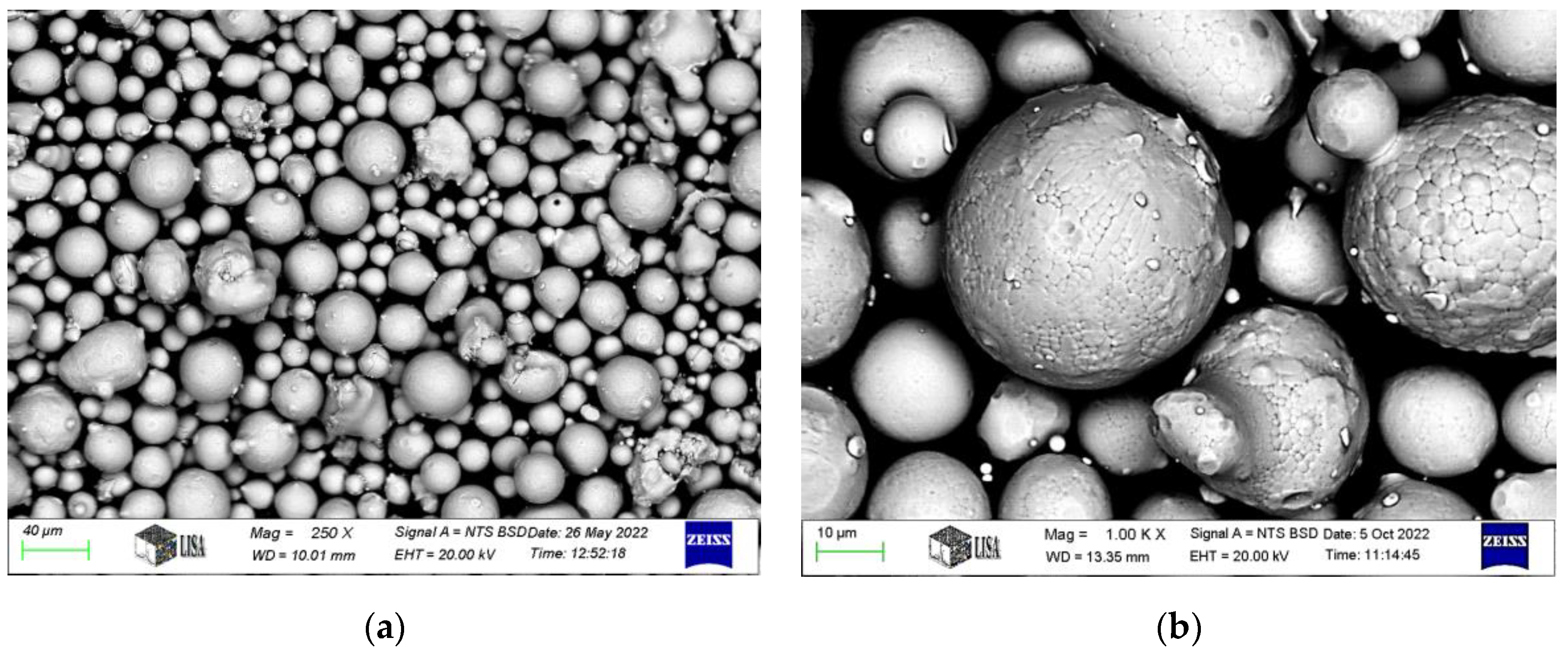
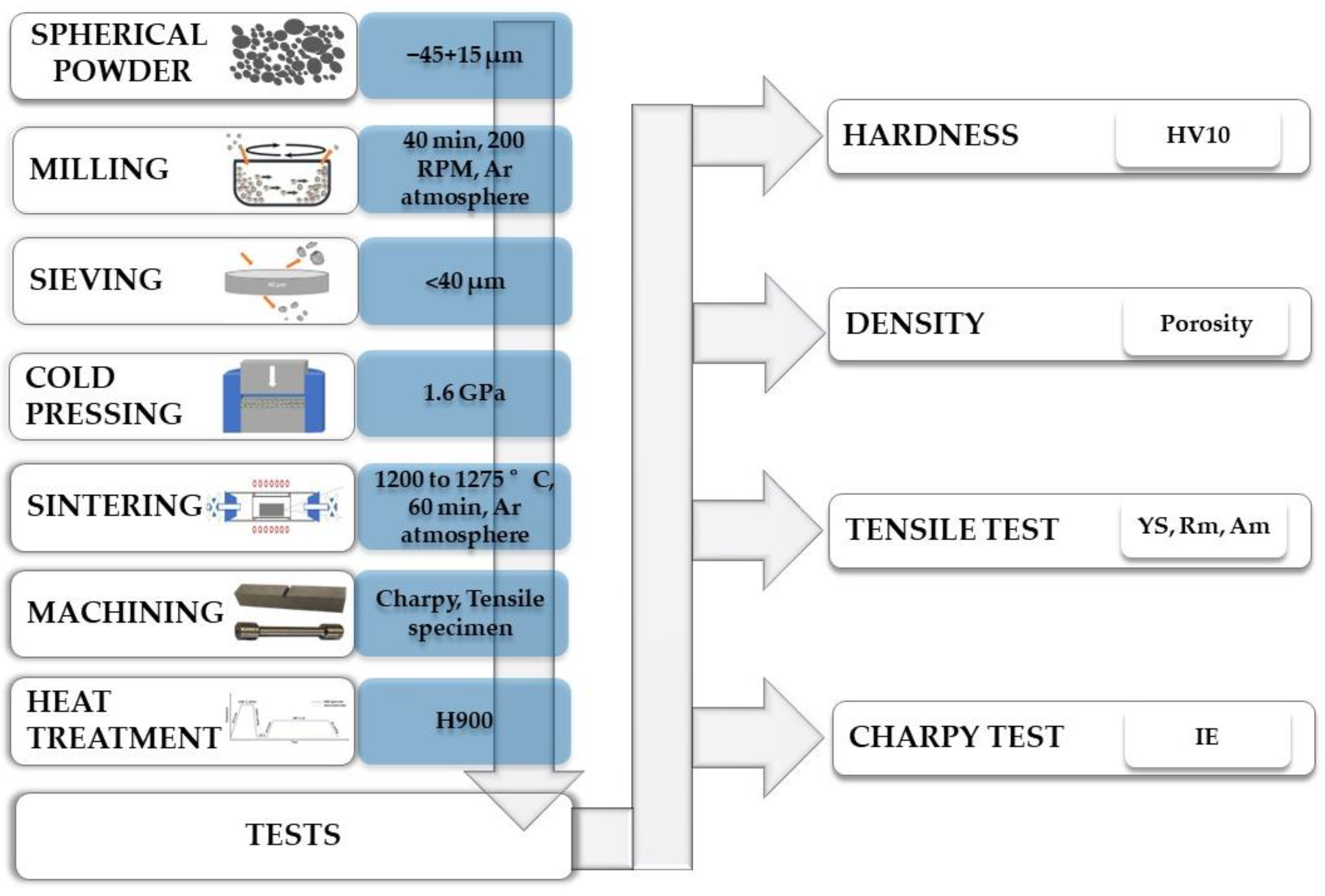
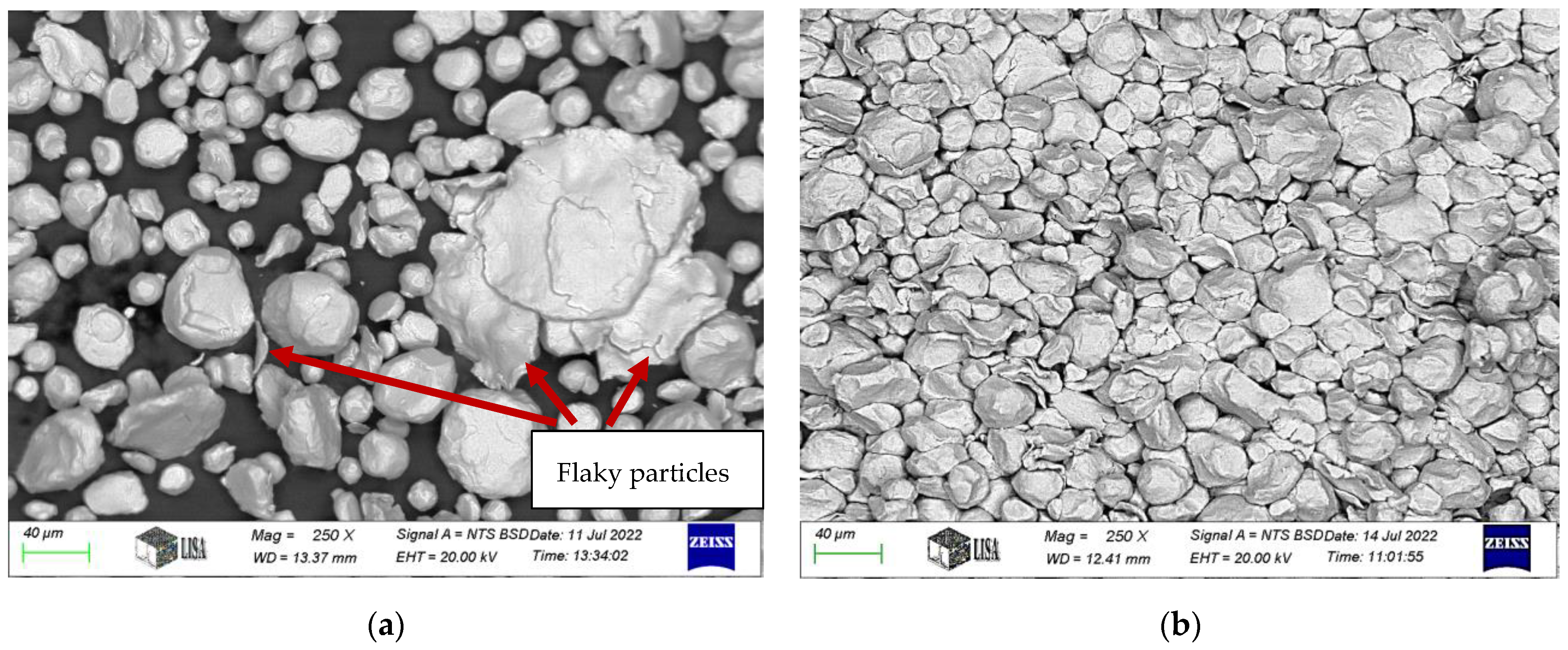
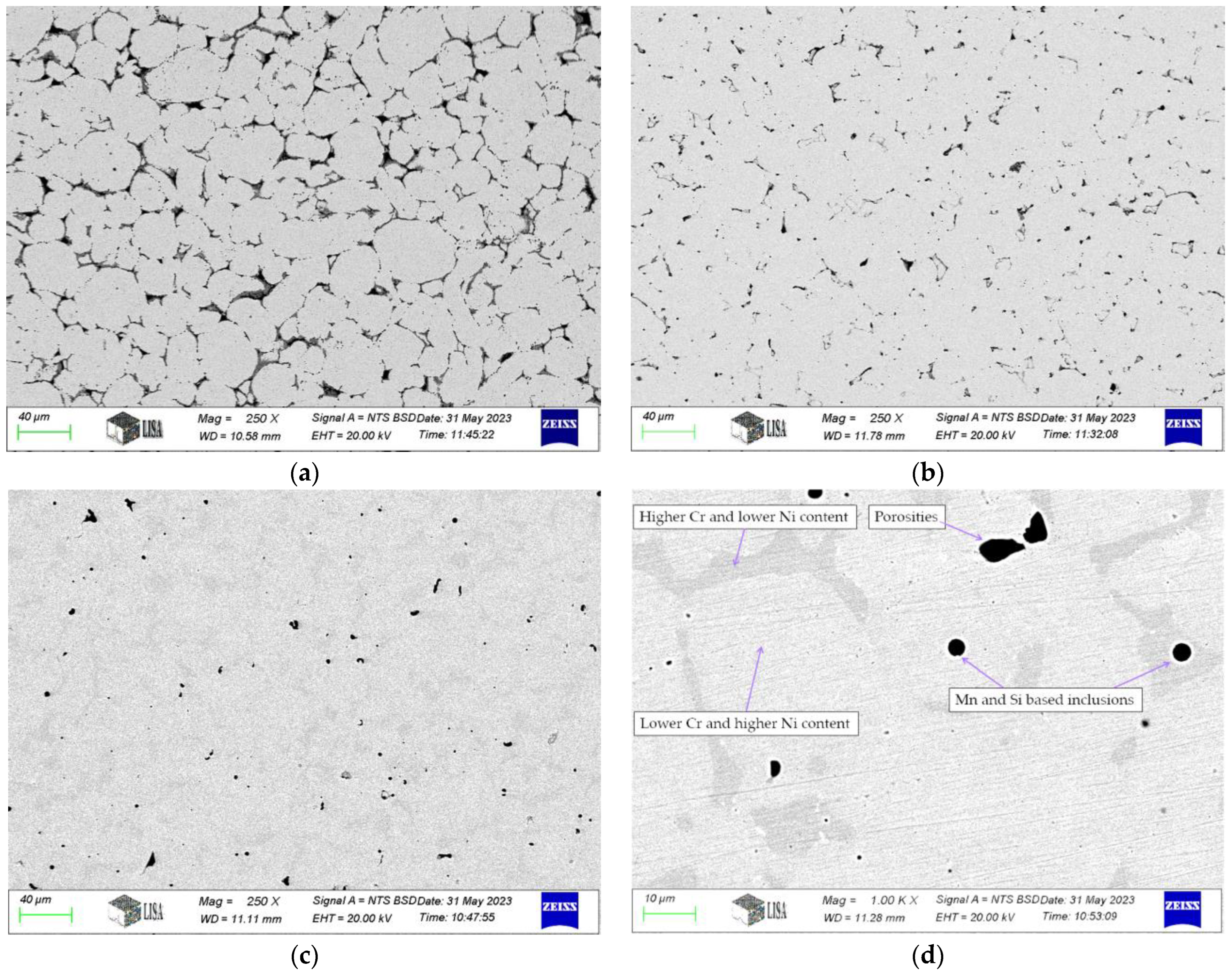
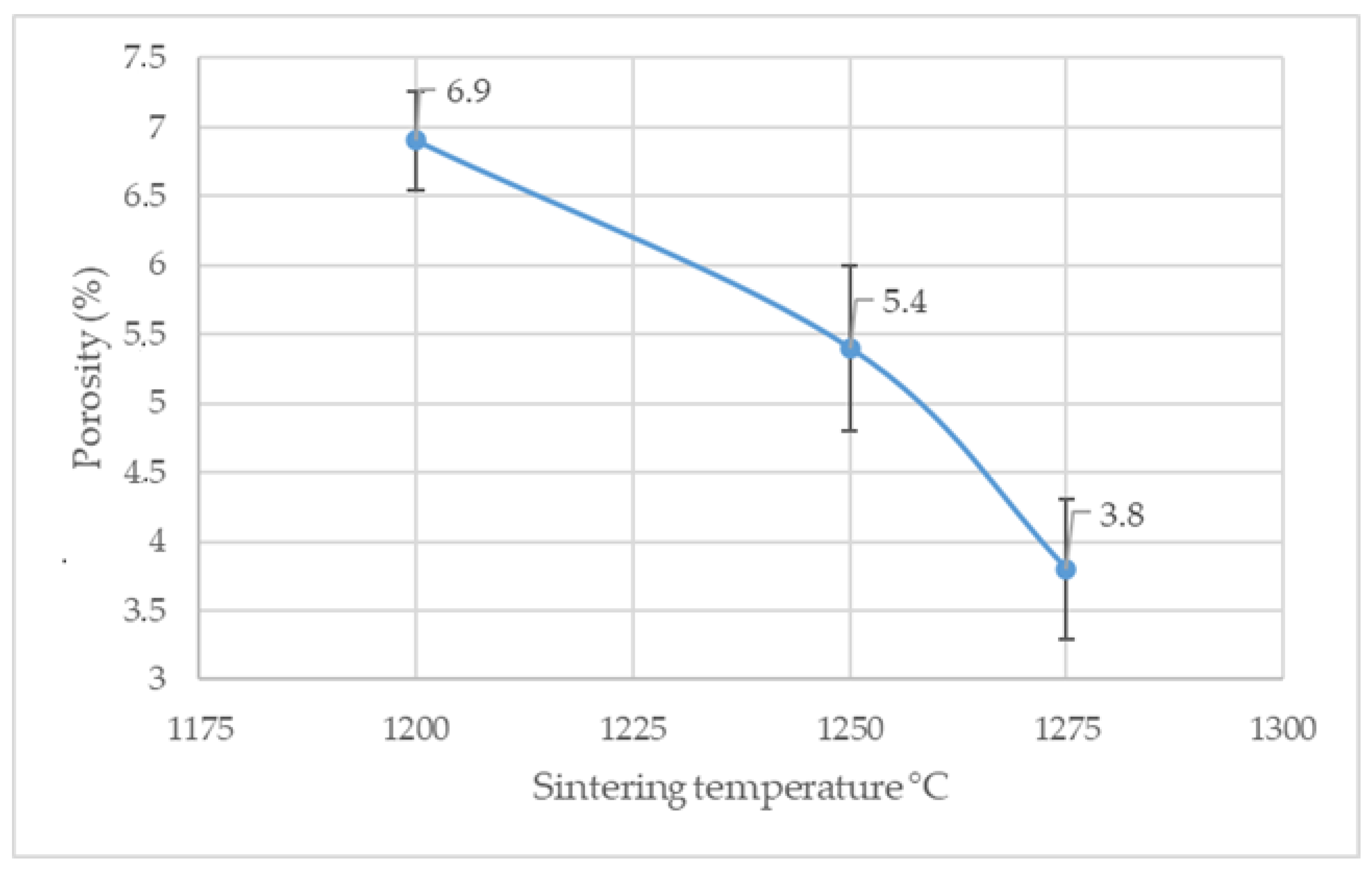

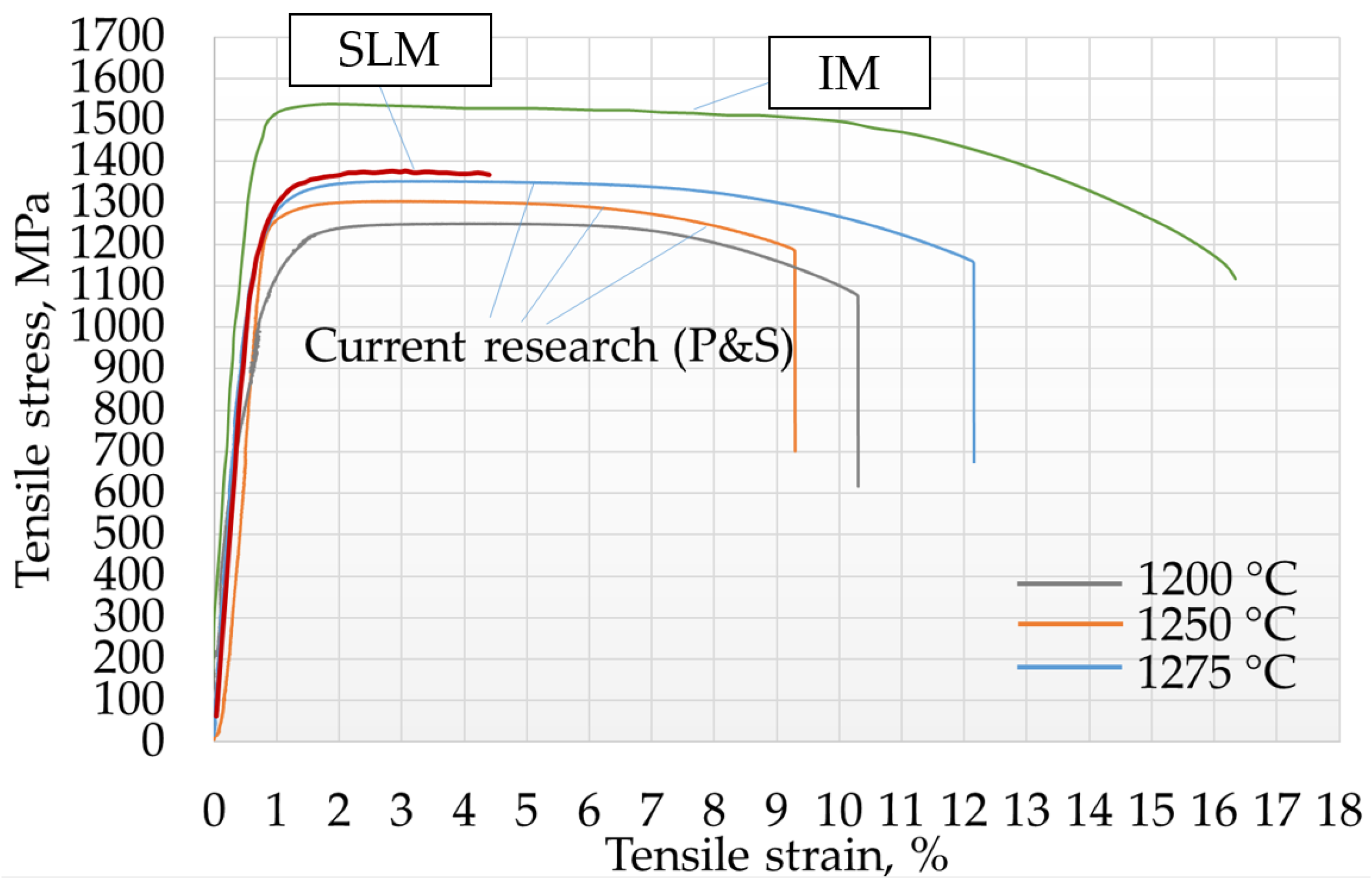
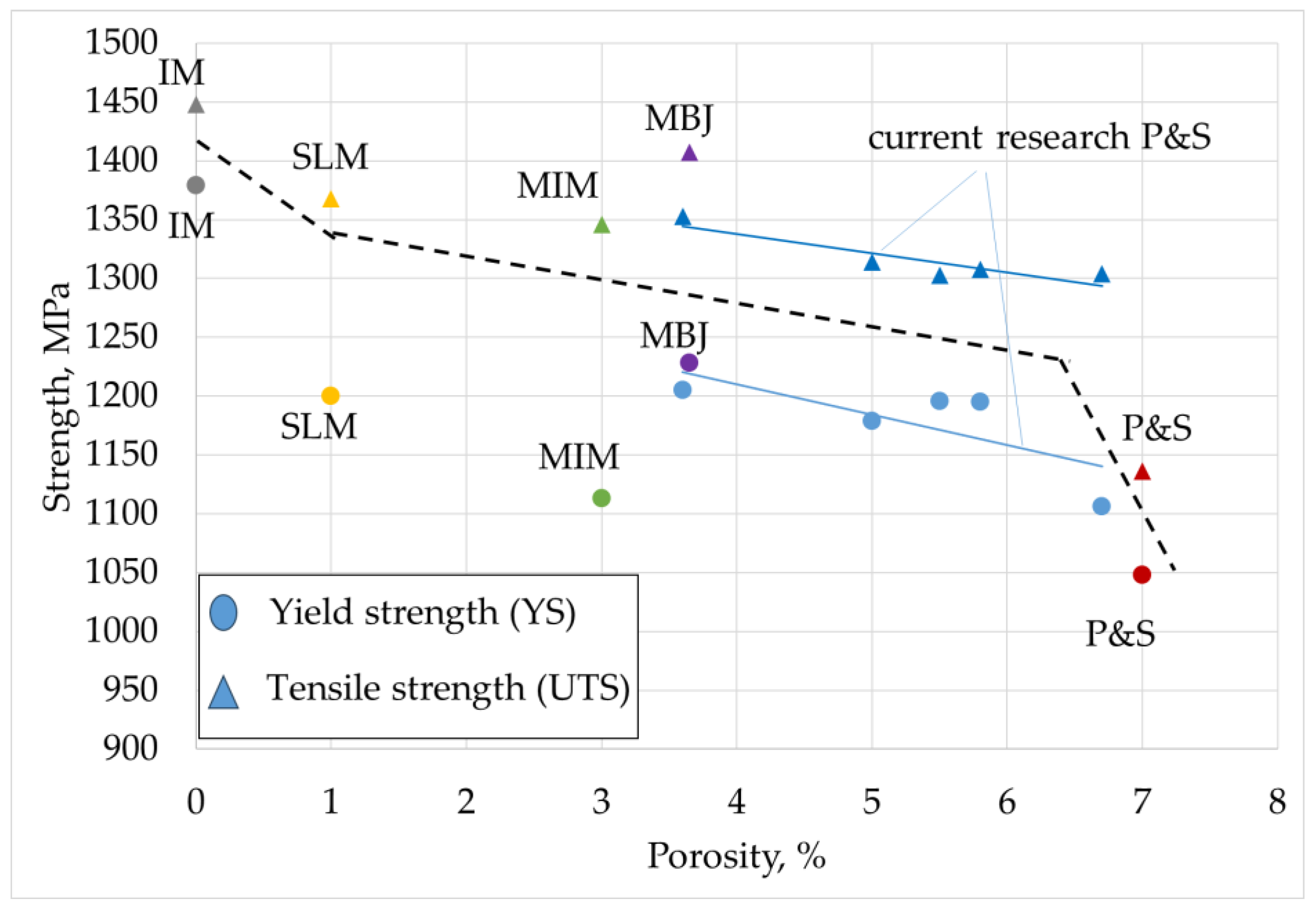


| Applied Technology | State | Porosity (%) | Hardness | Yield Strength (MPa) | Tensile Strength (MPa) | Fracture Strain (%) | Impact Energy (Joule) | Ref. |
|---|---|---|---|---|---|---|---|---|
| IM (wrought) | H900 | 0 | 43 HRC | 14.68 | [5] | |||
| H900 | 0 | 39 HRC | 1170 | 1390 | 5 | [6] | ||
| H900 | 0 | 45 HRC | 1379 | 1448 | 7 | [7] | ||
| H900 | 0 | >38 HRC | >1070 | >1170 | >10 | >6.8 | [8] | |
| MIM | 1300 °C for 4 h | 2.3 | 280 HV | 765 | 770 | 2 | [9] | |
| 1350 °C for 1 h | <1 | 1000 | 7 | [10] | ||||
| H900 | <3 | 437 ± 15 HV | 1113 ± 27 | 1346 ± 16 | 7.8 ±1 | [11] | ||
| 3D Printing | H900 | <1 | 42 HRC | 1200 | 1368 | 2.6 | [6] | |
| <1 | 31 ± 1 HRC | 1090 ± 30 | 22 ± 0.5 | [12] | ||||
| <2.5 | 445 HV | 1190 ± 16 | 1309 ± 13 | 3.7 ± 0.7 | 6 | [3] | ||
| MBJ | H900 | 2.65 | 1079 ± 33 | 1294 ± 9 | 8.3 ± 3.6 | [4] | ||
| H900 + HIP | 1.18 | 1228 ± 74 | 1407 ± 15 | 15.5 ± 3 | [4] | |||
| P&S | 690 MPa; 1340/1 h H900 | 14.2 | 355 HV10 | 1147 | 2.4 | [13] | ||
| 760 MPa;1275/45 min | 7 | 448 HV100 | 1048 | 1136 | 1.4 | [14] | ||
| H900 | 7 | 1080 | 4.2 | [15] |
| Fe | Cr | Ni | Cu | Si | Mn | Nb | P | S | N | C |
|---|---|---|---|---|---|---|---|---|---|---|
| 73.16 | 16.86 | 4.63 | 4.00 | 0.44 | 0.44 | 0.31 | 0.0019 | 0.004 | 0.03 | 0.02 |
| H900 | H925 | H1025 | H1075 | H1100 | H1150 | H1150M | |
|---|---|---|---|---|---|---|---|
| HRC | >40 | >38 | >35 | >32 | >31 | >28 | >24 |
| KV23 (J) | n.d. | >6.8 | >20 | >27 | >34 | >41 | >75 |
Disclaimer/Publisher’s Note: The statements, opinions and data contained in all publications are solely those of the individual author(s) and contributor(s) and not of MDPI and/or the editor(s). MDPI and/or the editor(s) disclaim responsibility for any injury to people or property resulting from any ideas, methods, instructions or products referred to in the content. |
© 2024 by the authors. Licensee MDPI, Basel, Switzerland. This article is an open access article distributed under the terms and conditions of the Creative Commons Attribution (CC BY) license (https://creativecommons.org/licenses/by/4.0/).
Share and Cite
Mikó, T.; Markatos, D.; Török, T.I.; Szabó, G.; Gácsi, Z. Minimizing Porosity in 17-4 PH Stainless Steel Compacts in a Modified Powder Metallurgical Process. J. Compos. Sci. 2024, 8, 277. https://doi.org/10.3390/jcs8070277
Mikó T, Markatos D, Török TI, Szabó G, Gácsi Z. Minimizing Porosity in 17-4 PH Stainless Steel Compacts in a Modified Powder Metallurgical Process. Journal of Composites Science. 2024; 8(7):277. https://doi.org/10.3390/jcs8070277
Chicago/Turabian StyleMikó, Tamás, Dionysios Markatos, Tamás I. Török, Gábor Szabó, and Zoltán Gácsi. 2024. "Minimizing Porosity in 17-4 PH Stainless Steel Compacts in a Modified Powder Metallurgical Process" Journal of Composites Science 8, no. 7: 277. https://doi.org/10.3390/jcs8070277
APA StyleMikó, T., Markatos, D., Török, T. I., Szabó, G., & Gácsi, Z. (2024). Minimizing Porosity in 17-4 PH Stainless Steel Compacts in a Modified Powder Metallurgical Process. Journal of Composites Science, 8(7), 277. https://doi.org/10.3390/jcs8070277






